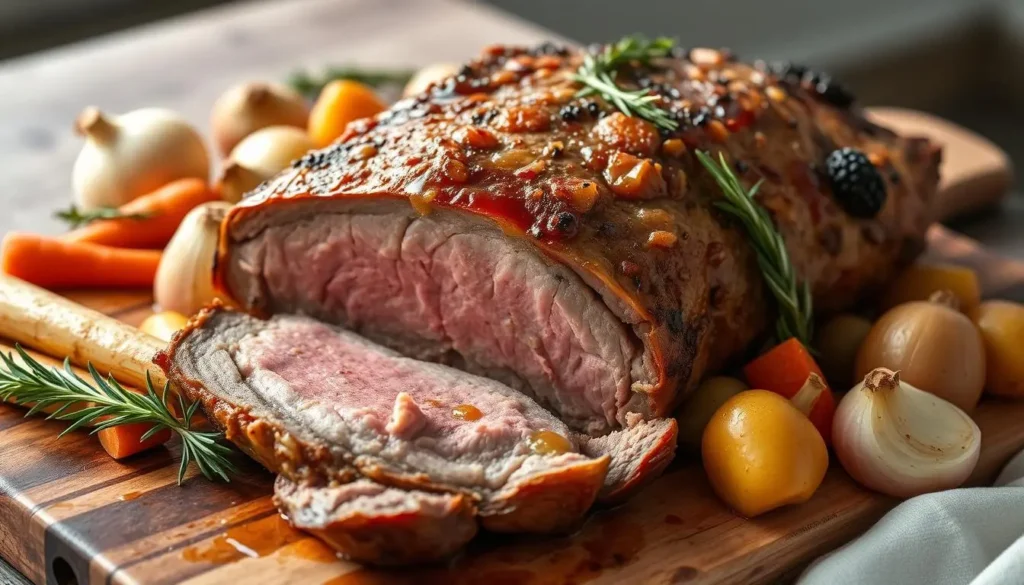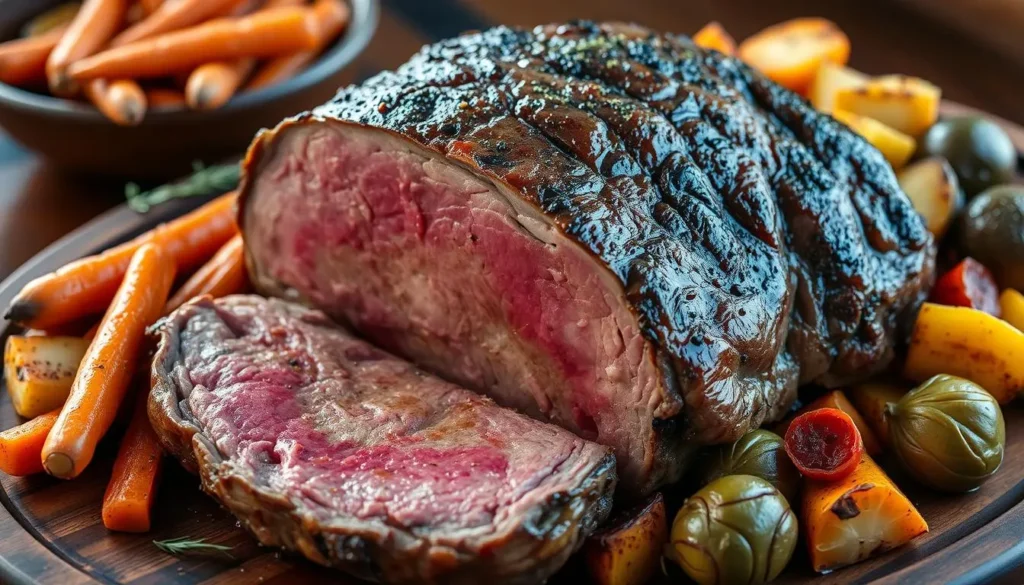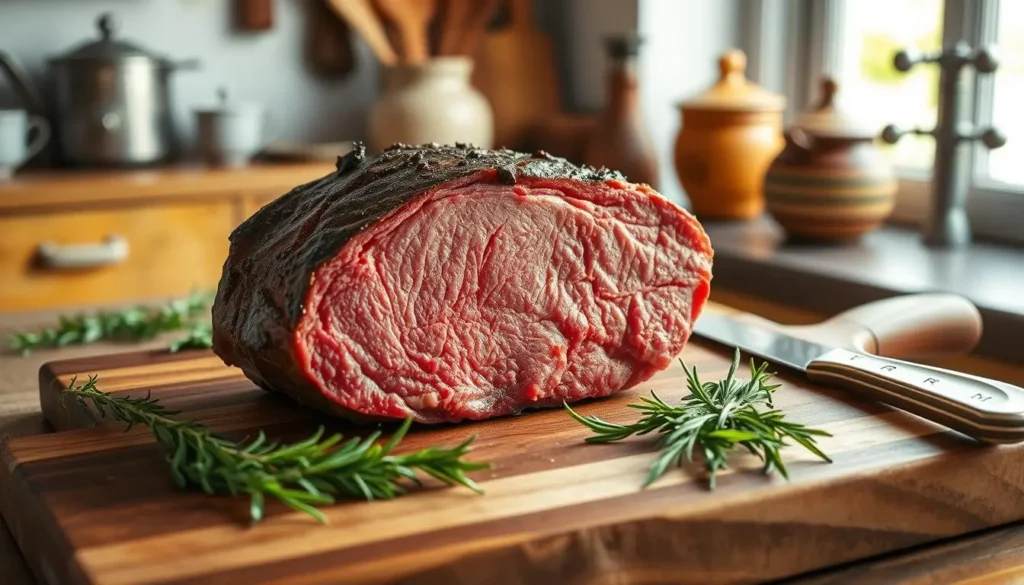Wondering how long to cook a bottom round roast for tenderness? The time needed varies based on the roast’s size, thickness, and your desired doneness. Understanding cooking time is key to a delicious, tender roast.
Cooking a bottom round roast can be tricky. But with the right guidance, you can get a tender, flavorful dish. Finding the right cooking time and temperature is crucial. Whether you’re new or experienced, knowing these factors is essential for a perfect roast.
Key Takeaways
- Understanding the factors that affect cooking time is crucial to achieving tenderness in a bottom round roast recipe.
- Cooking time varies depending on the size and thickness of the roast.
- Temperature plays a significant role in determining the perfect doneness of a bottom round roast.
- Achieving the perfect balance between cooking time and temperature is essential for a tender result.
- Mastering the perfect bottom round roast recipe requires practice and patience.
- Cooking time and temperature are critical factors in determining the tenderness of a bottom round roast.
- Following a reliable bottom round roast recipe can help you achieve a delicious and tender result.

Understanding Bottom Round Roast: An Overview
Wondering what a bottom round roast is good for? This beef cut is known for its rich flavor and tender texture. It’s perfect for many dishes. Plus, it has a good balance of protein, fat, and calories.
It’s important to know how to cook bottom round roast. This cut comes from the cow’s hindquarters, a muscular area. But, with the right cooking, it becomes tender and flavorful.
What Part of the Cow is Bottom Round?
The bottom round roast comes from the outside of the hind leg. This area is rich in connective tissue. This tissue makes the roast tender and flavorful when cooked slowly.
Characteristics of Bottom Round Roast
Bottom round roast is lean, flavorful, and tender when cooked right. It’s also more affordable than other beef cuts. This makes it a great choice for budget-conscious cooks.
Nutritional Profile
A 3-ounce serving of bottom round roast has about 150 calories, 25 grams of protein, and 5 grams of fat. It’s also a good source of vitamins and minerals like iron, zinc, and potassium.
The bottom round roast is versatile and flavorful, ideal for many dishes. It’s great for hearty stews or tender roasts. Its rich flavor and nutritional benefits make it a favorite among beef enthusiasts.
| Nutrient | Amount per 3-ounce serving |
|---|---|
| Calories | 150 |
| Protein | 25g |
| Fat | 5g |
| Iron | 10% of the Daily Value (DV) |
| Zinc | 20% of the DV |
| Potassium | 15% of the DV |
Different Names for Bottom Round Roast in American Butcher Shops
When you visit an American butcher shop, you might see the bottom round roast called different names. You might ask, what is another name for bottom round roast? The names can change based on where you are and the butcher shop. Let’s look at some names for the bottom round roast to help you feel more confident at the butcher shop.
In some places, it’s called the “round roast” or just “round.” In other areas, it’s known as the “rump roast” or “sirloin roast.” Knowing these names helps you pick the right meat for your recipe. You can ask your butcher about the name they use and what to look for in a good roast.
Here are some important things to remember when looking for a bottom round roast:
- Look for a lean cut of meat with minimal marbling
- Check the color, which should be a pale red or pinkish-red
- Choose a roast with a good balance of tenderness and flavor
By knowing the different names for the bottom round roast and what to look for, you’ll be able to find the perfect roast for your next meal. This makes shopping at the butcher shop easier and more enjoyable.
Preparing Your Bottom Round Roast for Cooking
To get tender and tasty results, you must prepare your bottom round roast right. First, let the roast come to room temperature. This makes it cook evenly. Leave it at room temperature for 30 minutes to 1 hour before cooking.
Room Temperature Guidelines
Leaving the roast at room temperature helps it relax. This makes it more open to seasoning techniques. It’s key for a tasty bottom round roast recipe.
Seasoning Techniques
Seasoning is where you add herbs and spices to boost the roast’s flavor. Here are some ways to season:
- Rub the roast with salt, pepper, and garlic powder
- Marinate it in vinegar or lemon juice
- Use a dry rub with herbs and spices
Essential Tools Needed
To cook a bottom round roast, you need a few tools. You’ll need a roasting pan, a meat thermometer, and a sharp knife. With these and the right seasoning, you’ll make a delicious bottom round roast recipe.
| Tool | Description |
|---|---|
| Roasting Pan | A large, heavy pan for roasting the bottom round roast |
| Meat Thermometer | A device to check the roast’s internal temperature |
| Sharp Knife | A sharp knife for slicing the roast after cooking |

Does a Bottom Round Roast Get More Tender the Longer You Cook It?
Many people wonder if a bottom round roast gets more tender with longer cooking. The answer is yes, but only up to a point. As you cook it, the meat’s connective tissues break down, making it tender. But, cooking it too long can make it dry and tough.
To get the roast just right, you need to think about cooking time. The size, thickness, and desired doneness all play a role. For instance, a bigger roast takes longer to cook than a smaller one.
Here are some tips for cooking a bottom round roast:
- Use a meat thermometer to ensure the roast reaches a safe internal temperature.
- Let the roast rest for a period of time before slicing to allow the juices to redistribute.
- Don’t overcook the roast, as this can lead to a dry and tough texture.
Understanding how cooking time affects tenderness is key to a delicious roast. Cook it for the right amount of time, considering all the factors. With practice, you’ll make a tender and tasty bottom round roast that everyone will love.
Ideal Cooking Methods for Bottom Round Roast
There are many ways to cook a bottom round roast. You can choose the method that fits your taste best. We’ll look at slow roasting, braising, and pressure cooking.
Slow roasting is a favorite for bottom round roast. It cooks at a low heat for a long time. This makes the meat tender and full of flavor. It’s great if you don’t want to watch the temperature and time closely.
Cooking Methods to Consider
- Slow roasting technique: cooking the roast at a low temperature for an extended period
- Braising method: cooking the roast in liquid to add moisture and flavor
- Pressure cooking approach: cooking the roast quickly using high pressure
Each method has its own benefits and downsides. Your choice depends on what you like and how you cook. Knowing about these methods helps you pick the best one for your roast.
Using the right method ensures your roast is tender and juicy. Whether you choose slow roasting or pressure cooking, pay attention to detail. This way, you’ll make a meal that everyone will remember.
Temperature Guidelines for Perfect Doneness
To get the perfect doneness, following temperature guidelines is key. When cooking a bottom round roast, it’s crucial to hit a safe internal temperature. This prevents foodborne illness. The ideal internal temperature is between 135°F and 140°F for medium-rare, 145°F to 150°F for medium, and 160°F to 170°F for well-done.
Using a meat thermometer is the best way to check your roast’s internal temperature. Stick the thermometer into the thickest part of the meat, avoiding fat or bone. Remember, the temperature will rise a bit after you take it out of the oven. So, it’s safer to remove it when it’s 5°F to 10°F below your desired doneness.
- Medium-rare: 135°F – 140°F
- Medium: 145°F – 150°F
- Well-done: 160°F – 170°F
By sticking to these temperature guidelines, you can get a delicious, tender bottom round roast. Always use a meat thermometer to make sure your roast is safe. And don’t be afraid to try different levels of doneness to find your favorite.
| Level of Doneness | Internal Temperature |
|---|---|
| Medium-rare | 135°F – 140°F |
| Medium | 145°F – 150°F |
| Well-done | 160°F – 170°F |
Best Marinades and Rubs for Tenderizing
To get a tender and tasty bottom round roast, the right marinades and rubs are key. Marinades, rubs, and tenderizing methods can greatly improve the taste. You can mix olive oil, garlic, and herbs to make your own marinades and rubs.
Acidic marinades are great for tenderizing. Vinegar or lemon juice in the marinade breaks down meat fibers, making it tender. Dry rubs, with spices, herbs, and sometimes sugar or salt, add flavor and tenderize the meat too.
Acidic Marinades
Acidic marinades are perfect for tenderizing bottom round roast. Mix olive oil, vinegar, and herbs like thyme and rosemary for a tasty marinade. The vinegar’s acid breaks down meat fibers, making it tender and flavorful.
Dry Rub Combinations
Dry rubs are great for tenderizing and flavoring your bottom round roast. Mix spices like paprika, garlic powder, and onion powder with brown sugar and salt. These rubs add deep flavor and tenderize the meat.
Always marinate or rub your bottom round roast for the right time. The marinating time varies based on the marinade or rub and your taste preferences. With the right marinades and rubs, you’ll get a tender and delicious roast that will wow everyone.
| Marinade Type | Ingredients | Marinating Time |
|---|---|---|
| Acidic Marinade | Olive oil, vinegar, herbs | 2-4 hours |
| Dry Rub | Spices, herbs, sugar, salt | 30 minutes to 1 hour |
How to Tell When Your Roast is Done
Checking if your roast is done is key to its tenderness and taste. To get it just right, you need to know the cooking time and how to check it. A meat thermometer is the best tool for this, as it shows the roast’s internal temperature.
Don’t forget to look at the meat’s color and feel. A good roast is tender, juicy, and has a brown crust. You can also check by gently pressing the meat with your finger. If it feels soft, it’s probably done.
- Use a meat thermometer to check the internal temperature of the roast.
- Look for visual cues, such as the color and texture of the meat.
- Use the touch test to check for firmness.
By following these tips and considering the cooking time, you can ensure your roast is cooked to perfection and enjoy a delicious, tender meal.
Remember, checking doneness is an important part of the cooking process, and it can make a big difference in the quality of your roast. By using a combination of methods, including a meat thermometer and visual cues, you can ensure your roast is cooked to perfection and enjoy a delicious meal.
Resting and Slicing Techniques
After cooking your roast, it’s key to let it rest before slicing. This step helps the juices spread out, making the meat tender and juicy. The resting time can vary, but 10-15 minutes is a good rule of thumb. This time allows the meat to relax and the juices to settle, making it easier to slice.
When slicing, cutting against the grain is important. This means you need to find the muscle lines on the meat’s surface. Once you know the grain direction, slice the roast thinly and evenly. This method makes the meat tender and flavorful.
Here are some tips for resting and slicing your roast:
- Let the roast rest for 10-15 minutes before slicing
- Cut against the grain to achieve tender and flavorful meat
- Use a sharp knife to slice the roast into thin, even pieces
- Slice the roast when it’s still slightly warm, as this will make it easier to slice and serve
By following these tips, you’ll get perfectly rested and sliced meat. Your bottom round roast will be a culinary delight. Always remember to cut against the grain and let the roast rest properly. These steps are crucial for the quality and flavor of your dish.
| Resting Time | Slicing Technique | Result |
|---|---|---|
| 10-15 minutes | Cut against the grain | Tender and flavorful meat |
| 5-10 minutes | Cut with the grain | Chewy and less flavorful meat |
Common Cooking Mistakes to Avoid
When cooking a bottom round roast, knowing common cooking mistakes is crucial. These errors can make your roast less tasty. Overcooking is a big mistake, making the roast dry and tough. Always check the roast’s internal temperature to avoid this.
Another mistake is not seasoning enough. Bottom round roasts love a good mix of seasonings and marinades. Try garlic, thyme, and rosemary for extra flavor. Proper seasoning makes a big difference in taste.
Not letting the roast rest is another big error. After cooking, let it sit before slicing. This lets the juices spread, making the roast tender and flavorful. By avoiding mistakes like these, you’ll get a great roast every time.
- Overcooking the roast
- Underseasoning the roast
- Not letting the roast rest
Being careful with these common cooking mistakes helps make a fantastic bottom round roast. With time and effort, you’ll cook a roast that wows everyone. Always focus on good cooking techniques and avoiding mistakes for the best results.
Storing and Reheating Leftover Roast
Having a tasty leftover roast is great. But, it’s key to store it right to keep its flavor and texture. The right storing and reheating methods can really enhance your roast’s taste.
Storing leftover roast needs some thought to avoid drying or contamination. You can keep it in airtight containers like glass or plastic with tight lids, or zip-top bags.
Storage Methods
- Refrigerate leftover roast at 40°F (4°C) or below within two hours of cooking.
- Freeze leftover roast at 0°F (-18°C) or below for longer storage.
- Use airtight containers or zip-top plastic bags to prevent moisture and other flavors from affecting the roast.
Reheating Without Drying
To reheat leftover roast without drying, try oven, microwave, or stovetop reheating. Always use low heat and add a bit of liquid, like broth or gravy, to keep it moist.
By using these storing and reheating tips, you can enjoy your leftover roast for days. Always remember to keep food safety in mind when storing and reheating to ensure a healthy meal.
| Storage Method | Temperature | Shelf Life |
|---|---|---|
| Refrigerate | 40°F (4°C) or below | 3 to 4 days |
| Freeze | 0°F (-18°C) or below | 3 to 4 months |

Conclusion: Mastering the Perfect Bottom Round Roast
Cooking the perfect bottom round roast is all about finding the right balance. It’s about knowing the special qualities of this beef cut. This way, you can make sure it’s always tender and full of flavor.
Don’t forget to let the roast rest before slicing. And always cut against the grain. This will help you avoid mistakes like overcooking or not seasoning enough.
With these tips, you’re ready to become a pro at making the perfect bottom round roast. Enjoy every delicious bite and the satisfaction of a job well done!
FAQ
What part of the cow is the bottom round roast?
The bottom round roast comes from the cow’s hindquarters. It’s from the round primal cut. This cut is tough but lean, needing special cooking to be tender.
What are the characteristics of a bottom round roast?
Bottom round roast is tough and lean with a unique flavor. It has lots of connective tissue, making it less tender. But, with the right cooking, it can become tender and tasty.
What is the nutritional profile of a bottom round roast?
Bottom round roast is lean and full of nutrients. It’s packed with protein and vitamins like iron, zinc, and B vitamins. It’s also low in fat, making it a healthy choice.
What are the different names used to refer to a bottom round roast in American butcher shops?
In American butcher shops, it’s also called a rump roast, round roast, or eye of round roast. These names all mean the same thing: the hindquarters of the cow.
Does a bottom round roast get more tender the longer you cook it?
Not always. Longer cooking can soften the meat, but too much can make it dry. Finding the right cooking time and temperature is key.
What are the best cooking methods for a bottom round roast?
The best ways to cook it are slow roasting, braising, and pressure cooking. These methods break down the tough tissue, making the roast tender and flavorful.
What temperature guidelines should I follow to ensure my bottom round roast is cooked to perfection?
For medium-rare, aim for 130-135°F. For medium, 140-145°F. For well-done, 155-160°F. Use a meat thermometer to check the temperature.
What are the best marinades and rubs for tenderizing a bottom round roast?
Acidic marinades like vinegar, wine, or citrus can soften the meat. Dry rubs with herbs, spices, and salt also help make it tender and flavorful.
How can I tell when my bottom round roast is done?
Use a meat thermometer to check the temperature. Also, look at the meat’s color and how easily a fork pierces it to see if it’s done.
What is the proper way to rest and slice a bottom round roast?
Let it rest for 15-20 minutes before slicing. This lets the juices spread evenly. Slice against the grain for the most tender slices.
What are some common cooking mistakes to avoid when preparing a bottom round roast?
Avoid overcooking, not seasoning well, and not letting it rest. Also, don’t open the oven or pressure cooker too often to keep the meat tender.
How should I store and reheat leftover bottom round roast?
Store it in an airtight container in the fridge for up to 4 days. Reheat it gently to keep it moist. Use a low oven, a skillet with broth, or a microwave with a damp towel.

